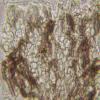
12-12-2025 18:39
Mirek GrycHello everyone.Macrofeatures similar to Mollisia b

09-12-2025 12:06
 Andgelo Mombert
Andgelo Mombert
Bonjour,Je recherche l'article concernant Hypobryo

07-12-2025 16:07
Arnold BüschlenHallo, ich habe in einer Moos-Aufsammlung (epiphy

08-12-2025 21:04
Mark Stevens"Hello everyone,I'm relatively new to microscopy (

08-12-2025 18:59
 Lothar Krieglsteiner
Lothar Krieglsteiner
.. found by a seminar-participant, I do not know t

08-12-2025 17:37
 Lothar Krieglsteiner
Lothar Krieglsteiner
20.6.25, on branch of Abies infected and thickened
Voici un mini disco qui a poussé sur une feuille morte de Physocarpe doré
Peut-être un Microscypha ?
Merci de nous aider encore.
Amitiés, Roland
Données :
Substrat : feuille morte
Spores étroitement ellipsoïdes, légèrement atténuées-obtuses à un bout, lisses, avec rares petites guttules difficiles à préciser, 6-8 x 1,5-2 µm, 6,9 x 1,9 µm en moyenne, Q = 3,63
Asques à 8 spores bisériées, avec crochet à la base et appareil apical amyloïde, à contenu dextrinoïde, 22-41 x 5-6 µm
Paraphyses cylindriques, parfois légèrement élargies ou atténuées-obtuses à l'apex, septées et fourchues à la base, à contenu très difficile à préciser (rares petites guttules vers la base ?), 22-45 x 1,5-2 um, ne dépassant pas les asques ou très peu
Medulla en textura celluleux ? Difficile à préciser, car dans une substance gélatineuse
Excipulum ectal en textura porrecta
Poils marginaux cylindriques, finement échinulés, multiseptés, à section apicale mesurant jusqu'à 45 x 4 um, bruns
Poils externes semblables, mais plus courts, bruns

The ectal excipulum should be of a hyaline t. globulosa with brown external patches.
The species seems restricted to leaves of Salix. On Betula leaves occurs something very similar: Pyrenop. betulicola
Was this found recently or the last year?
Zotto
The leaves are : ''Physocarpe doré''
We will check again the ectal excipulum.
Roland
Then Microscypha or Pyrenopeziza fuckelii ?
Roland

"Physocarpe doré" = Physocarpus opulifolius

The type of Microscypha is M. grisella = M. arenula, and I do not believe that this species on ferns is mollisiaceous, mabye rather related to Urceolella.
The present fungus P. fuckelii s.l. fits quite well in Pyrenopeziza, in my opinion.
Zotto
That's what I want to know Hans !
And thank you for your help,
Roland

I must apologize, a friend (Ingo Wagner) drew my attention to the warty hairs of your fungus, and that it could rather be a Fuscolachnum instead of a Pyrenopeziza. Apparently F. misellum from Rubus leaves is not very different. Considering that Physocarpus is also a Rosaceae, we imagine that your fungus might be in fact F. misellum. ?
Zotto



